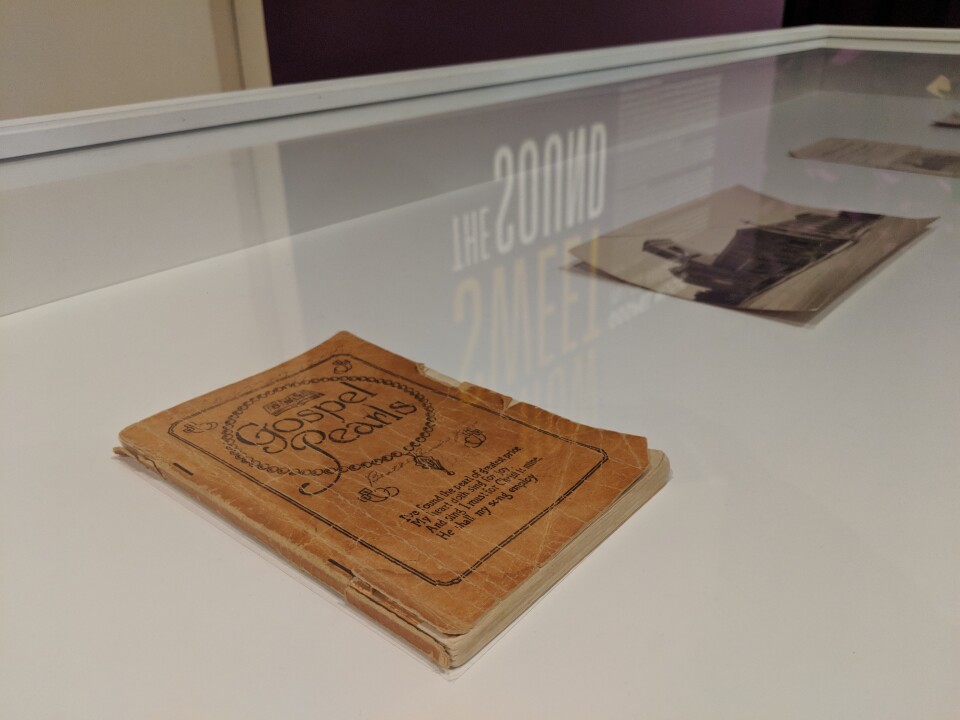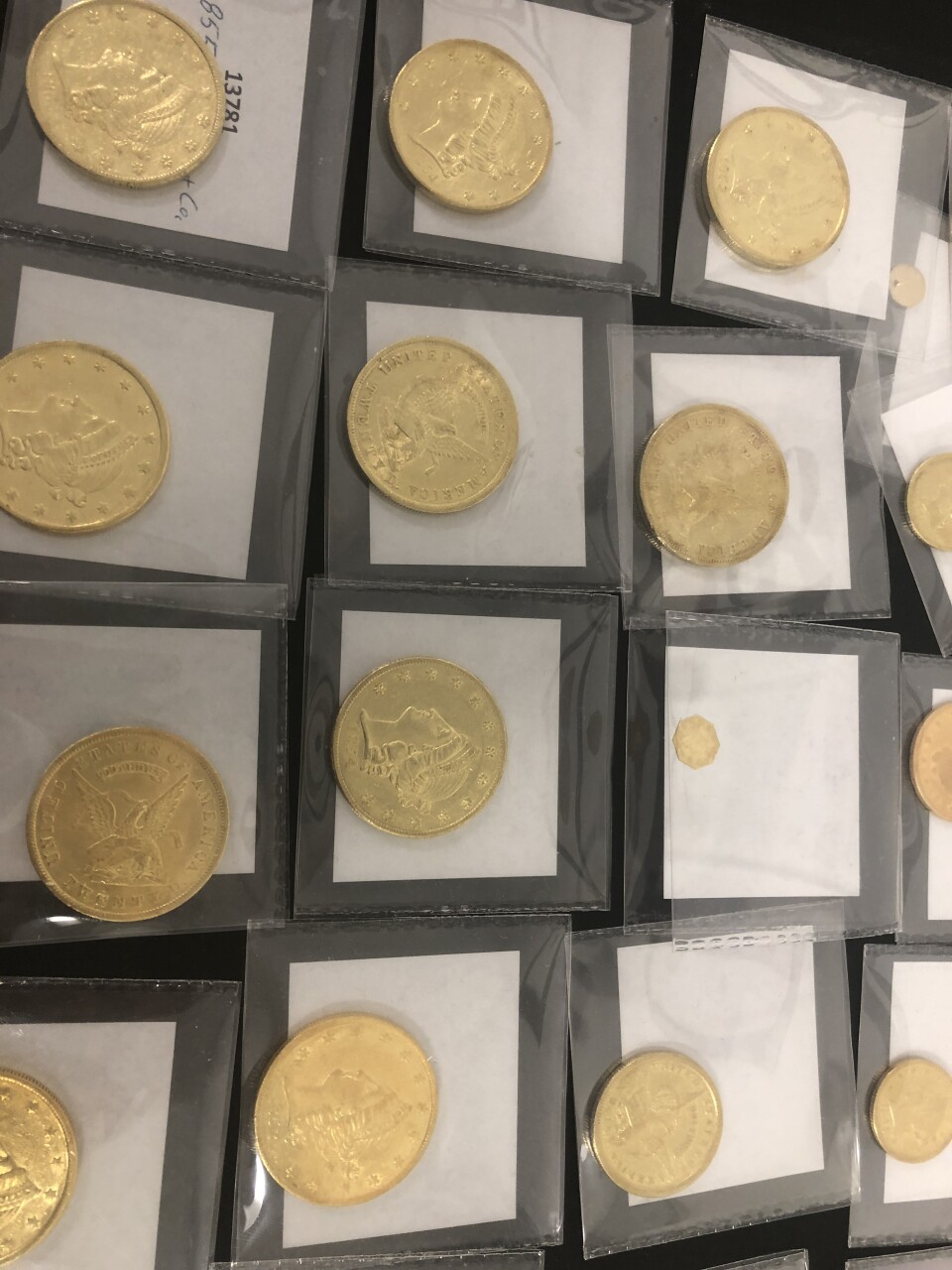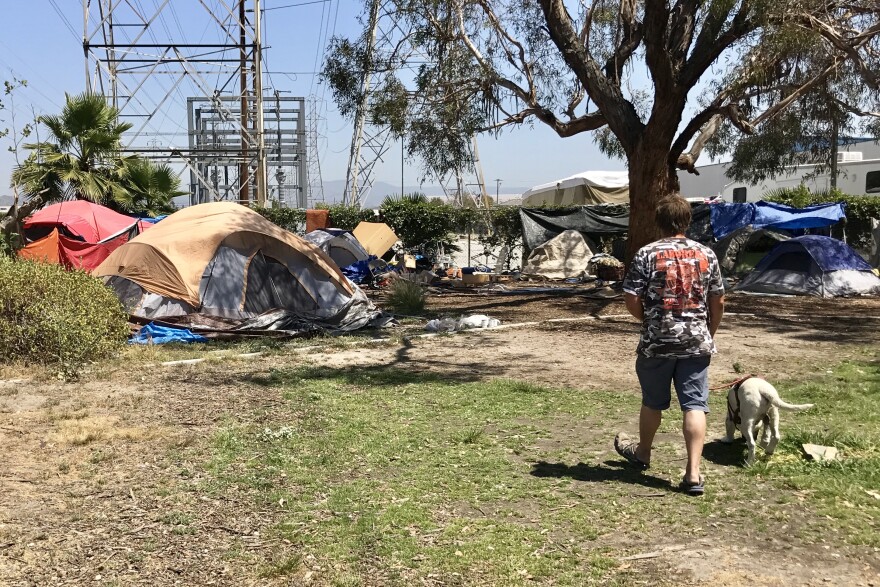The challenges of clearing homeless from the Santa Ana River trail, touring a new exhibit at the California African-American Museum, recovering gold from a shipwreck.
Orange County struggles to find motels to house homeless
Orange County moved some homeless into motels for 30 days. What happens next?
Last week, OC Board of Supervisors chairman Andrew Do told a federal judge that the county would provide motel rooms and other forms of shelter to those cleared out of the Santa Ana River camp.
The plan was hammered out after Judge David Carter warned that the homeless were removed from the camp without first being given a place to go. The county ultimately agreed to pay for the rooms for 30 days.
So how did the county get motel operators on board?
Take Two spoke to Chairman Do to find out.
Before I made that representation to the court, I spent the lunch hour talking to non-profit and philanthropic communities and worked with community leaders to tell them that we have this need and without this resource — i.e. the hotel rooms — we wouldn't be able to move ahead.
We have a group of us in Orange County who are of like mind and they got on the phone. Between them and our staff at the healthcare agency and Susan Price, our director of care coordination, they were able to put together a significant number of motel rooms.
How much are you paying hotel operators?
I don't really have the exact numbers. The range I was told from the beginning was anywhere from $75 to $125. These are not the normal motels or hotels for tourists — we're talking about a particular type of accommodation that's not in the high-visibility areas or frequented by tourists. It's more in the neighborhood, so they tend to be lower rent anyway, to begin with.
What happens next for these people?
We're working through them now. We've never gone through a process like this, as you can imagine. We are relocating an entire area with potentially up to 600-700 people at one time. The challenge is: OK, so once we offload these individuals off of the riverbed, then our attention should focus on the next 30 days.
If there's a person who was living on the riverbed that smoothly went into a motel room and now has 30 days... When those 30 days are up, what's the plan for that person?
The plan is for them to go into transitional housing with wrap-around services.
(Answers have been edited for clarity and brevity.)
Winners and losers of the ongoing cold snap
It was only last week that we were talking about how spring had sprung early this year. But now, we're in the midst of a cold snap. Temperatures this week have dipped as low as 38 degrees. That's frigid by Los Angeles standards.
It doesn't seem like it's going to let up, either. So what effect are these dramatic temperature swings having all around the Golden State? We looked into this month's cold snap winners and losers.
Loser: Avocado toast
John Krist is the chief executive officer for the Farm Bureau of Ventura County. He explained that local agriculture is vulnerable to these lower temperatures, particularly because just last week, the warm spell caused an early bloom.
"If you have an orchard in an area where the warm temperatures, the crazy temperatures the past few weeks pushed the trees to bloom and then you got hit with freezing temperatures the last couple of nights, you're going to lose those blossoms and that's going to decrease your fruit production for the fall."
Those fall fruits were part of next year's fruits. So if they're affected, it means avocado toast may be getting more expensive. However, Krist said, there's no reason to get upset just yet.
"We're talking about a relatively small percentage of the acreage that's affected," Krist said, "so I think we'll be able to provide affordable avocados next year despite the cold temperatures of this week."
We're not out of the woods yet, though. Cold temps are forecast well into next week.
Winner: Winter recreation
But where there are losers to this week's cold spell, there are also winners. Big Bear and winter sports are among them.
As Darien Schaefer, CEO of the Big Bear Visitors Bureau, explained, last month's temperature slump got the skiing season off to a slow start:
"This year our activity has been a little lower than last year because last year was one of those special years where we got three feet of snow back in November and it carried us through the entire season and Mother Nature has been a little stingier.
At times we were down anywhere from 15% to 20% from last year. This forecast for the next 10 or 15 days should really bring our numbers right back up."
But similar to the farming industry, the effects of the cold snap will be felt well into the future. Unlike farmers, that's a good thing.
"When we get more snow, obviously that's great for the ski areas or the tubing hill or just snow play in general. When all that snow then melts and comes down into our lake, Big Bear Lake is a great recreational aspect of our community through the summer months.
So, snow for us has a double impact not just for the ski areas but for the lake itself."
But it's not summer yet, so until then, keep your boots and warm coats close.
How LA shaped gospel music
Gospel music sprouted from the pews and pulpits of African American churches in the South. But gospel music also shaped Los Angeles and L.A. shaped gospel, as featured in the new California African American Museum exhibit, "How Sweet the Sound."
"Especially when you get to the 1960s and '70s, people are very conscientious of the commercialization of gospel music," says historian Daniel Walker from the USC Center for Religion and Civic Culture, who collaborated on the exhibit. "The history of gospel music is that it goes through these changes about every 30 years where it sounds too commercial, too R&B, and then somebody else rejects it."

The exhibition showcases the very beginnings of the genre with a small hymnal dated to the 1920s, "Gospel Pearls," which is the National Baptist Convention songbook.
"From it, the term 'gospel music' was coined and adopted by black churches because of its dissemination," says Tyree Boyd-Pates, exhibition curator and program manager at the museum.
But also on display is the album, "Amazing Grace," a live album by Aretha Franklin recorded at L.A.'s New Temple Missionary Baptist Church in 1972.

"It was just local African Americans in South Los Angeles who were sitting in the pews and were sitting behind her," Boyd-Pates says. "It literally catapulted not only her career, but a genre that everyone had been participating in for decades."
It remains the bestselling disc of her career and the highest-selling live gospel album of all time, and demonstrates the power of the genre in pop culture.
"The issue of commercialization," Walker says, "was always seen as a means of spreading the gospel."
While L.A.'s burgeoning music scene may have put a secular twang on gospel, it allowed the luminaries from that world, such as Franklin, Sam Cooke and James Cleveland, to collaborate and amplify their reach.

Gospel is still alive in L.A., and not just in black churches and not just on Sundays.
"My son is a serious gospel singer, but he's director of a gospel choir at Wilson High School in Long Beach," Walker says. "If there's 20 kids in the choir, only about four or five of them are African-American. They're Filipino, they're Cambodian, they're Mexican, they're Anglo, and they're all singing gospel."

4 ways the 2018 Honda Gold Wing is like a car
The Honda Gold Wing has long had a reputation as the Cadillac of motorcycles, but the 2018 version makes that even more true. The decades-old touring bike is clearly taking a page from Honda's automotive division, adding features that are more commonly found on cars.
Apple CarPlay
Dozens of auto makers offer this in vehicles with four wheels, but the Gold Wing is the first to incorporate it on a motorcycle. Plugging an iPhone into the bike with a USB cable (both of which store in a cubby on top of the gas tank) syncs the phone's controls with the motorcycle, allowing riders to make and receive phone calls, send and dictate text messages, get directions and listen to music -- while riding -- using voice commands spoken into a Bluetooth-enabled helmet.
Airbag
The Gold Wing is the only motorcycle on the market with a built-in airbag. Available on some touring versions of the 2018, the airbag will automatically inflate in front of the rider if the crash sensors on the bike detect changes in acceleration resulting from a forward collision.
Automatic transmission, including reverse
The dual-clutch seven-speed transmission is available on some models of the 2018, letting riders roll across the pavement without having to shift unless they want to. A walking/reverse feature can move the bike under power at walking speed, both forward and backward, with the rider seated in the saddle -- a godsend on a bike that tips the scales at a minimum of 787 pounds.
An engine even larger than some Honda Civics
Motorcyclists measure their engines in cubic centimeters, and the 2018 Gold Wing's a big one -- 1,832 cc. In car speak, that makes it a 1.8-liter. And it's a six cylinder, which makes it bigger than the one used to power one of Honda's most popular cars -- the Civic EX-T.
So if you're ready, do like Sue, and hit the road!
Treasure from the California Gold Rush lost in a shipwreck is now back in SoCal
Treasure from the California gold rush that was lost in a shipwreck is finally coming home. The gold recovered from the SS Central America is now in Long Beach for a public display. The exhibition at the Long Beach Convention Center opens February 22 and runs through February 24, 2018.
Bob Evans is a geologist and the chief scientist for the project. He told Take Two the story of the ship and its treasure. The SS Central America was traveling between Panama and New York in 1857 when it hit a hurricane and sank with tons of gold from the California Gold Rush, Evans said.
The ship was actually found 30 years ago, so Evans said he's looking forward to displaying the findings.
I have been working on this treasure since the early 1980s, actually, so I've been waiting for this for a long time.
Evans walked us through the work he's doing to painstakingly remove the dirt and deposits from each piece of gold.

The technical term for this process is 'curating,' from the Latin word for 'to care,' Evans said. Some might call this 'cleaning,' but that has a negative connotation as a harsh process in the world for coin enthusiasts.
First the coins take a soak in a special solution that Evans formulated to take into account the softness of gold compared to other metals.

Once this process is done, Evans rinses the coins and then uses special artist's brushes, working under a microscope to ensure there are no deposits left in the tiny ridges and indents of the coins.

When the coin is completely spotless, Evans rinses it again and uses a hairdryer to dry it.

Evans catalogues each coin and artifact after he's finished working with it. The treasure includes gold dust and bars in addition to a variety of coins, including foreign-made coins and some from private mints.
The signature coin of the SS Central America is the 1857 double eagle, Evans said. The coin was worth $20 back then, but now, thanks to the shipwreck keeping the coins out of circulation and in good condition, they're worth much more.
When a coin is in mint state condition, this can add many, many multiples of value to a coin's worth. A double eagle in absolutely perfect condition can run into the six figures, over $100,ooo for that particular ounce of gold.
There are also smaller coins, some worth less than a dollar called California fractional gold pieces.

The gold bars are called assayers' ingots. A gold miner would bring in the raw gold dust and nuggets to an assayer who would melt them into a block like this stamped with the gold's dollar value.

This treasure is a key piece of California history because of its gold rush ties, Evans said.
When gold was discovered in California, now there was a reason to have a state in California. All these people went there; there was enough population to make it a state and it was so important economically. That's what this shipwreck and this story and the ship itself were all about, the transfer of wealth from California to New York and the rest of the world. That's what made this the greatest lost treasure in United States history.




